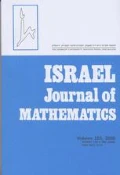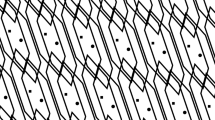Abstract
We give a geometrical interpretation of the Brudnyi-KrugljakK-divisibility theorem—one of the fundamental results of modern interpolation theory of Banach spaces. We show that this result is closely connected with a curious intersection theorem which can be formulated in the spirit of Helly’s classical theorem. LetB 0,B 1 be two closed convex balanced subset of a Banach spaceX. We prove that under a wide range of various conditions the family of setsB = {B =sB 0 +tB 1 +c;s, t ∈R,c ∈X} possesses the following intersection property:
LetB′ be a subfamily ofB such that every two sets fromB′ have a common point. Then ∩ B∈B′ γ oB ≠ 0, where γ>0 is an absolute constant (γ ≤ 7 + 4 √2) and the symbol γ oB denotes a dilation ofB with respect to its center by a factor of γ.
As a consequence we obtain a generalization of theK-divisibility theorem for sums of two elements.
Similar content being viewed by others
References
[BK1] Yu. Brudnyi and N. Krugljak,Real interpolation functors, Doklady Akademii Nauk SSSR256 (1981), 14–17; English transl.: Soviet Mathematics Doklady23 (1981), 5–8.
[BK2] Yu. Brudnyi and N. Krugljak,Interpolation Functors and Interpolation Spaces, I, North-Holland Math. Library47, North-Holland, Amsterdam, 1991.
[BL] J. Bergh and J. Löfström,Interpolation Spaces. An Introduction, Springer-Verlag, Berlin, 1976.
[BS] Yu. Brudnyi and A. Shteinberg,Calderón couples of Lipschitz spaces, Journal of Functional Analysis191 (1995), 459–498.
[BSh] C. Bennet and R. Sharpley,K-divisibility and a theorem of Lorentz and Shimogaki, Proceedings of the American Mathematical Society96 (1986), 585–592.
[C] M. Cwikel,K-divisibility of the K-functional and Calderón couples, Arkiv för Mathematik22 (1984), 39–162.
[CJM] M. Cwikel, B. Jawerth and M. Milman,On the fundamental lemma of interpolation theory, Journal of Approximation Theory60 (1990), 70–82.
[DGK] L. Danzer, B. Grünbaum and V. Klee,Helly’s Theorem and its relatives, inConvexity, Proceedings of Symposia in Pure Mathematics7 (1963), 101–180.
[K] N. Krugljak, On the reiteration property of\(\overrightarrow X _{\phi ,q} \) spaces, Mathematica Scandinavica73 (1993), 65–80.
[K1] N. Krugljak,Private communication.
[M] M. Milman,Extrapolation and Optimal Decomposition, Lecture Notes in Mathematics1580, Springer-Verlag, Berlin, 1994.
[N1] P. Nilsson,Reiteration theorems for real interpolation and approximation spaces, Annali di Matematica Pura ed Applicata132 (1982), 291–330.
[N2] P. Nilsson,Interpolation of Calderón pairs and Ovchinnikov pairs, Annali di Matematica Pura ed Applicata134 (1983), 201–232.
[S] P. Shvartsman,K-divisibility and interpolation of weighted Lipschitz spaces, in preparation.
Author information
Authors and Affiliations
Corresponding author
Additional information
Supported by the Center for Absorption in Science, Israel Ministry of Immigrant Absorption and by grant No. 95-00225 from the United States-Israel Binational Science Foundation (BSF), Jerusalem, Israel.
Rights and permissions
About this article
Cite this article
Shvartsman, P. A geometrical approach to theK-divisibility problem. Isr. J. Math. 103, 289–318 (1998). https://doi.org/10.1007/BF02762277
Received:
Revised:
Issue Date:
DOI: https://doi.org/10.1007/BF02762277




